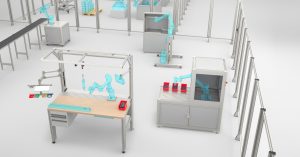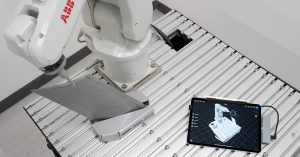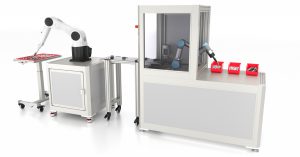“INNA”, the multifunctional robot cell developed by automation specialist INperfektion and cobot dealer Niederrhein Automation, enables industrial companies and craft businesses – including SMEs – to venture into the world of robotics.
Nowadays, automated welding is no longer restricted to large companies and heavy-duty industrial robots. Lightweight robots that are ideal for beginners can also be taught to perform the joining process and can therefore be used, for example, as welding robots for small series – provided they are equipped with the right tool and have a skilled professional to teach them. Thanks to these lightweight robots – also frequently referred to as “cobots” – automated welding is affordable, even for SMEs. For example, cobots can provide valuable support for series production in an SME, as Wissam Nehme from the sales team at item pluspartner INperfektion explains: “To weld a seam manually, you need to be a genuine welding expert. However, there is an alternative – you can use a robot that has been configured by one of these experts. All that’s then left for you to do is to clamp the material in place and remove it afterward – the robot does everything else.”
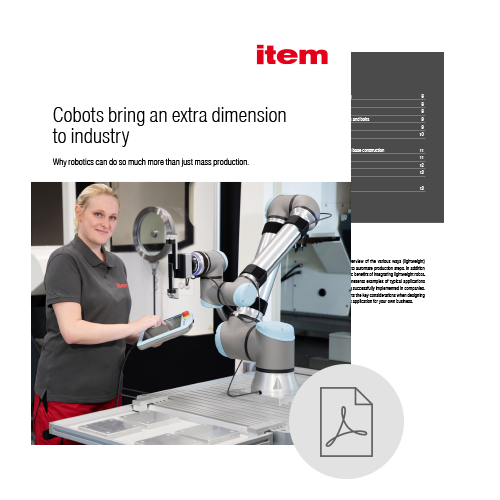
An overview of robot applications
Read our white paper to discover specific applications and other advantages of robotics in industry – and explore why lightweight robotics is a particularly worthwhile investment for small and medium-sized enterprises.
GO TO THE DOWNLOAD
Automated welding as a practical test for the robot cell
One of the reasons why automated welding is now a viable option, even for SMEs, is that cobots make it relatively easy for businesses to take their first steps into the world of robotics. “Because state-of-the-art lightweight robots are so easy to understand and operate, you don’t need any automation or programming experience to use them efficiently,” Nehme explains. INperfektion sees great potential in robotic solutions, especially when it comes to maintaining the same high standards of quality in craft businesses and industry in spite of the skills shortage. To make it possible for even SMEs to tap into this potential, INperfektion worked in partnership with robotics and automation specialist Niederrhein Automation to develop “INNA”, a multifunctional robot cell. Besides automated welding, INNA can be used for a wide range of tasks such as grinding, milling or gluing – provided that the integrated Doosan cobot is equipped with the relevant end effector.
If the robot can weld safely inside the cell, then it can carry out grinding, deburring and similar tasks in there safely, too.
To create the basis for this versatility, INNA was initially optimised for automated welding, as Sven Gerards, Managing Director of Niederrhein Automation, explains: “Welding is one of the most demanding disciplines, so it was the ideal starting point as far as we were concerned. After all, if the robot can weld safely inside the cell, then it can carry out grinding, deburring and similar tasks in there safely, too.” The two companies chose Line XMS from item as the base for INNA. Nehme explains the reasons for this choice: “The item products are perfect for the integration of robotics, because they are suitable for universal use and offer free scalability in terms of both quantities and dimensions. What’s more, it’s really easy to expand or modify existing constructions.”
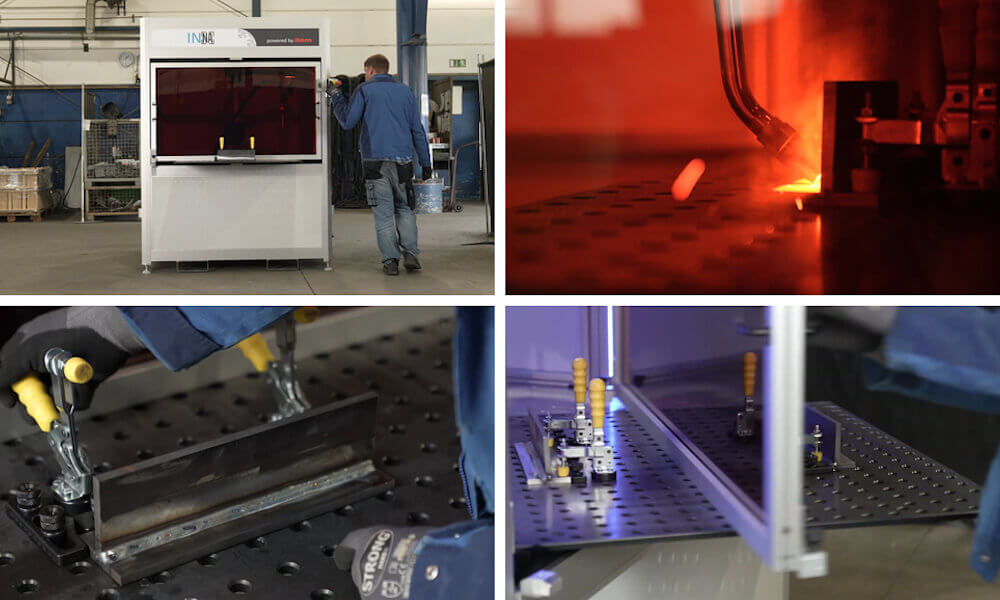
INNA in use – specialist welding company reports on its experience
A particularly exciting chapter in INNA’s history came about by pure chance. One of the first times the robot cell was used in practice as an automated welding solution was at a location just a few hundred metres to the south of its “birthplace” – namely in the workshop of DAST Schweisstechnik GmbH, which is barely 250 metres away from the INperfektion headquarters in the German town of Wegberg, close to the border with the Netherlands. DAST Schweisstechnik – a family-owned business that also takes on trainees and manufactures individual and small part series for industry – put INNA through its paces on its own initiative. A customer enquiry about series production was the key driver of this development, as Denise Wagels, who works in the company owned by her father, Dieter Wagels, explains: “The customer wanted us to produce thousands of boilers, each with seven points that needed to be welded with millimetre precision. When preparing our cost estimate, we didn’t manage to achieve the customer’s desired price and it suddenly struck me that what we needed for this order was a robot!”
If it hadn’t been for INNA, we would never have received this customer order. What’s more, we were fairly quick to come up with ideas about how else we could use the robot cell – and not just for this particular order.
Denise Wagels’ idea met with some misgivings to begin with: “My father didn’t think it would be worth our while investing in a robot, so we decided to give our neighbours at INperfektion a call. After all, that’s their area of expertise. They immediately invited us round to meet INNA.” This phone call definitely proved worthwhile. “My father has now come to recognise the benefits of automated welding and has been completely won over. If it hadn’t been for INNA, we would never have received this customer order. What’s more, we were fairly quick to come up with ideas about how else we could use the robot cell – and not just for this particular order,” she explains.
Automated welding – an opportunity for SMEs
The positive experiences reported by DAST Schweisstechnik demonstrate that automated welding is possible even for SMEs, but that’s not all – they also show how robots help address the shortage of skilled workers and relieve the strain on staff, who certainly don’t find themselves short of things to do. As Denise Wagels explains: “The robot cannot replace human staff. Although it can perform the actual welding process, it can neither set the welding parameters itself nor assess the results. When it comes to these tasks, we still need a skilled professional.” However, once the robot has been configured as required, it can largely work autonomously, which leaves the human welding experts free to focus on other tasks. “We’ve really noticed just how much the robot has reduced our workload. We now more or less just need one person to see to the robot – in other words, to load and unload it. What’s more, that person doesn’t need to be an expert,” Denise Wagels emphasises.
Operating state-of-the-art lightweight robots is now so easy that even employees with no particular robotics skills can very quickly teach a robot to perform tasks that don’t change, which the robot then reliably repeats exactly the same way each time. This employee might be a skilled welder, for example.
Sven Gerards from Niederrhein Automation highlights the safety aspect: “One of the major advantages of welding with INNA is that the robot cell boosts safety in the production facility enormously.” Nehme from INperfektion is keen to encourage SMEs in particular to start using robotics: “Operating state-of-the-art lightweight robots is now so easy that even employees with no particular robotics skills can very quickly teach a robot to perform tasks that don’t change, which the robot then reliably repeats exactly the same way each time. This employee might be a skilled welder, for example – you don’t need a programmer.” Denise Wagels adds: “I hope our positive experience will encourage other companies to give robotics a go.”

Want all the latest updates on innovative robotics applications? Simply subscribe to the item blog by completing the box at the top right.


